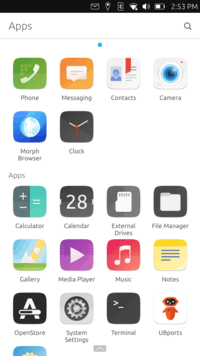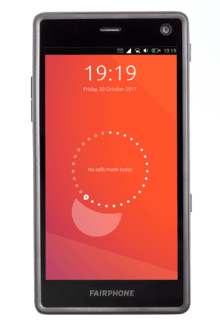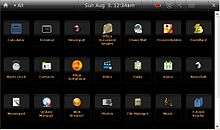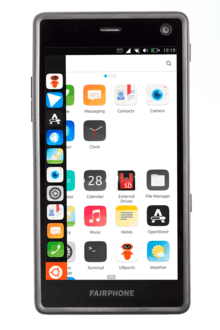Ubuntu Touch
Ubuntu Touch (also known as Ubuntu Phone) is a mobile version of the Ubuntu operating system, being developed by the UBports community.[3][4][5] Written in Qt, it is designed primarily for touchscreen mobile devices such as smartphones and tablet computers, but the original goal of convergence was intended to bring Ubuntu Touch to laptops, desktops, IOT devices, TVs and smart watches for a complete unified user experience.
 The Ubuntu Touch home screen showing applications | |
| Developer | UBports, Ubuntu community, previously Canonical Ltd. |
|---|---|
| OS family | Unix-like |
| Source model | Open-source |
| Latest release | 16.04 OTA-12 / 13 May 2020[1] |
| Latest preview | OTA-12 / 19 April 2020[2] |
| Marketing target | Smartphones, tablets, mobile devices |
| Available in | Multilingual |
| Update method | Click Update Manager, Image Based Updates, apt-get |
| Package manager | Click packages dpkg |
| Platforms | ARM |
| Kernel type | Linux kernel |
| Default user interface | Graphical (Native and Web applications) |
| License | Mainly the GPL and various other open source licenses |
| Official website | https://ubuntu-touch.io |
The project was started by Canonical Ltd. but Mark Shuttleworth announced that Canonical would terminate support due to lack of market interest on 5 April 2017.[6][7] It was then adopted by UBports as a community project.[8] The UBports project was seeded by Marius Gripsgard in 2015 and the programming source code was transferred to the UBports Foundation where it now resides. UBports' mission is to support the collaborative development of Ubuntu Touch and to promote its widespread use.
History
The Ubuntu Touch project was started in 2011. Mark Shuttleworth announced on 31 October 2011 that by Ubuntu 14.04, the goal was that Ubuntu would support smartphones, tablets, smart TVs and other smart screens (such as car head units and smartwatches),[9] but to date has only been supported by vendors on a few smartphones, one tablet and a number of third-party devices which hobbyists have ported the operating system to. The initial goal set by Shuttleworth for Ubuntu was to reach full convergence (same platform and libraries on all devices).[10] The Ubuntu platform for phones was unveiled on 2 January 2013.[11] The Ubuntu Touch Developer Preview was released on 21 February 2013.[12]

Canonical released Ubuntu Touch 1.0, the first developer/partner version on 17 October 2013, along with Ubuntu 13.10 that "primarily supports the Galaxy Nexus and Nexus 4 phones, though there are images available for other phones and tablets",[13] and released a "relatively 'stable' build for wider testing and feedback" on 17 April 2014,[14] along with Ubuntu 14.04. A preview version of the software is available for installation on certain additional Android handsets including the Samsung Galaxy S4 Google Edition as a Developer Preview as of 21 February 2013. Developers have access to all of the source code under a license allowing modification and redistribution of the software.[12]
Ubuntu Touch was released to manufacturers on 16 September 2014.[15] BQ Aquaris E4.5 Ubuntu Edition, the world's first Ubuntu-based smartphone went on sale in Europe on 9 February 2015.[16]
In April 2016, the world's first Ubuntu-based tablet, the BQ Aquaris M10 Ubuntu Edition, was released.[17]
In August 2016, OTA-13 was announced to support Android 6.0 BSP.[18]
In August 2018, UBPorts released its OTA-4, upgrading the Ubuntu Touch's base from the Canonical's starting Ubuntu 15.04 "Vivid Vervet" to the nearest, current long-term support version Ubuntu 16.04 LTS "Xenial Xerus".[19]
Ubuntu for Android
Ubuntu for Android was a variant of Ubuntu designed to run on Android phones.[20] It was expected to come pre-loaded on several phones.[21] An Ubuntu for Android mock-up was shown at Mobile World Congress 2012.[22][23] A Developer Preview was released in February 2013[24] but as of April 2014, this project is no longer under active development by Canonical.[25][26]
It would contain different graphical interfaces: when the device is connected to a desktop monitor, it features a standard Ubuntu Desktop interface (Unity). When the device is connected to a TV, the interface featured is the Ubuntu TV experience.[27] It would have the ability to run standard Ubuntu Desktop applications[28] and also the ability to run Android applications on the Ubuntu Desktop.[29] which includes apps to make and receive calls and SMS messages directly from the desktop.[28][30] Developers will be able to create one app, with two interfaces: a smartphone UI, and, when docked, a desktop UI.[31]
A phone running Ubuntu for Android has to meet several requirements such as a dual-core 1 GHz CPU, video acceleration through a shared kernel driver with associated X driver; OpenGL, ES/EGL, 2 GB storage, HDMI for video-out with secondary frame buffer device, USB host mode and 512 MB RAM.[28]
Ubuntu Mobile

Ubuntu Mobile Internet Device Edition is a discontinued Ubuntu distribution planned to run on the Intel Mobile Internet Device platform, x86 mobile computers based on the Intel Atom processor. It was planned to use the GNOME framework Hildon as the basis for its GUI. In June 2008, Ubuntu Mobile 8.04 was released.[32][33] Ubuntu Mobile ended active development in 2009 after 9.10 Alpha 6.[34]
Equipment producers would have been able to customize their distributions, including options such as Flash, Java, or custom interfaces.[35]
According to Canonical, Ubuntu Mobile would provide an "uncompromised Web 2.0 experience". It was to include features such as Web browsing, email, media, camera, VoIP, instant messaging, GPS, blogging, digital TV, games, contacts, and calendars, with regular software updates.[35]
Features
Ubuntu Touch uses the Qt 5-based[36] touch user interface and various software frameworks originally developed for Maemo and MeeGo such as oFono as telephony stack,[37] accounts-sso for single sign-on,[38][39] and Maliit for input.[40] Using libhybris[41][42] the system can often be used with Linux kernels used in Android, which makes it easily ported to most recent Android smartphones.[43]
Libertine is Ubuntu's project to run traditional desktop X applications.[44]
Lock screen
When Ubuntu Touch is turned on no lock screen immediately appears, as applications will prompt the user to unlock if necessary when they are opened. The centre of the "Welcome Screen" is a visualisation of activity on the device. It shows the user's status and recent events on the welcome screen, completed with a design around the circle which reflects activity on the phone over the preceding month.[45]
Included applications

Ubuntu Touch includes core applications such a calculator, an e-mail client, an alarm clock, a file manager, and even a terminal among others. Twelve or more core applications are currently being developed.[46] Several Ubuntu Touch applications work on the desktop as well, including Browser, Calendar, Clocks, Gallery, Notes, Reminders, Terminal, and Weather.[47]
Side stage
Side stage was introduced in 2013[48] and allows users to run both "tablet apps" and "phone apps" side by side, resizing each on the top as and when you need to see more of them.[49][50] It aims to "go even further" with the idea of multitasking, allowing screen space to be divided in this manner. Examples shown in the announcement video included a notes app being used alongside a web browser, and a user swiping from the right edge to bring a mobile version of the Facebook app into view over a playing video.
Design
Users can access the whole system by swiping from the edges of the screen. A short swipe from the left edge allows for instant access to applications pinned to the launcher, while swiping all the way across reveals the home scope, which can be set by the user. This menu is available from the home screen and any running app.[51]
Ubuntu Touch's multitasking is accessed by swiping the finger from the right edge of the screen to the left, which switches to the previous application (short swipe) or shows all open apps (long swipe). Swiping up from the bottom is used to show or hide tools specific to the app being used, which gives Ubuntu Phone the ability to run applications with a large, uncluttered canvas by default.[52]
Target market
Mark Shuttleworth, the founder of the company Canonical Ltd., believed that Ubuntu for phones will first find a niche in countries where Ubuntu is well known; more specifically, developing markets such as India and China where computers have Ubuntu pre-installed. However, the success of Ubuntu Phone in these markets is difficult to predict.[53]
Despite Ubuntu's popularity among open source developers, penetrating the legacy-bound business market will continue to be somewhat challenging for Ubuntu. Companies employing the "bring your own device" (BYOD) method have already adapted to using Android and iOS devices and the benefits posed by Ubuntu may not be adequately considered.[54]
Requirements
Hardware
Ubuntu Touch requires that a system's CPU support certain hardware features.
| Criteria | Mid to high end devices |
|---|---|
| Processor architecture | ARM Cortex-A7 |
| Memory | 1 GB |
| Flash storage | 8 GB eMMC |
| Multi-touch | Yes |
| Entry level consumer Ubuntu tablet | High-end Ubuntu enterprise tablet | |
|---|---|---|
| Processor architecture | Dual-core ARM Cortex-A15 | Quad-core ARM Cortex-A15 or Intel x86 |
| Memory | 2 GB preferred | 4 GB preferred |
| Flash storage | 8 GB minimum | 8 GB minimum |
| Screen size | 7–10-inch | 10–12-inch |
| Multi-touch | 4 fingers | 4–10 fingers |
| Full desktop convergence | No | Yes |
Reception
Adrian Covert, writing for CNN on 2 January 2013, predicted that the operating system will not gain wide use, stating, "carving out a niche in the seemingly unshakable mobile space—ruled by the Android-and-Apple duopoly—still requires a critical mass of users and a lively ecosystem of app developers. Realistically speaking, the chances of this even upstaging Windows Phone or BlackBerry 10 are slim. At best, Ubuntu seems like a sandbox for the most enthusiastic early adopters and a cheap enterprise solution for companies on a tight budget."[59]
Joey Sneddon of OMG! Ubuntu disagreed with Covert's assessment, writing, "commentators like Covert are missing the point. See, Ubuntu Phones aren't really going to claw much market share away from Apple or Google. And this neat 'dock your phone and use it as a desktop' feature, whilst innovative, won't be the main lure for many […]. During his keynote address earlier this week, Mark Shuttleworth continually referred to 'emerging' markets as the battleground on which an Ubuntu Phone would fight it out for impact […]. It's this sector, the low-end, that the battle for the hearts, minds and hands of the less tech-savvy will take place."[60]
Rich Trenholm writing for CNET on 27 February 2013, "[…] But on first impression I'm hugely taken with Ubuntu Touch. It's elegant, thoughtful, and versatile, while remaining beautifully straightforward. […] it's by far the strongest potential rival to Android, iOS, and Windows Phone. In fact, I prefer it to iOS, which long ago lost its shine, and heck, maybe even to Android, too. Fingers crossed that manufacturers and phone carriers get behind it, because I'd happily lay down my own cash for an Ubuntu Touch phone."[61]
Jason Jenkins, writing for CNET on 27 February 2013, MWC Awards 2013, "[…] Lots was said about the impressive number of carriers and manufacturers Firefox OS has lined up behind it. But once put to a vote, Ubuntu Touch was the clear winner, with Firefox OS the runner-up. The team thought that Ubuntu Touch, the tablet version of which we got our hands-on for the first time at MWC, feels more like the complete package at this point. […]"[62]
Jesse Smith from DistroWatch Weekly reviewed the Ubuntu Phone in Meizu Pro 5 lauding the price, interface, responsiveness and frequency of updates, calling it a "pleasant phone and communications experience" and distinguished it as a user-oriented device as opposed to Android's application-oriented nature and noted that it would be more likely to appeal to those interested in technology—Linux fans in particular—but was too new to appeal to the public at large. This was due, in part, to the limited selection of phone apps, partially due to the small size of the market, but stated that LibreOffice and GIMP were available. It took him a while to understand what differentiated scopes from applications. He also noted that the platform was free of advertisements.[63]
Commercially available devices
- In February 2015, the BQ Aquaris E4.5 Ubuntu Edition became the first smartphone with Ubuntu Touch preinstalled.[64] It was sold in the European Union only.[65]
- In May 2015, the Meizu MX4 Ubuntu Edition went on sale in China, becoming the second Ubuntu phone.[66]
- On 9 June 2015, BQ launched another smartphone running Ubuntu Touch, the Aquaris E5 Ubuntu Edition.[67]
- On 5 February 2016, BQ announced the first commercial Ubuntu Touch tablet, the Aquaris M10 Ubuntu Edition, which was released in April 2016.[68]
- In April 2016, Meizu released the Meizu PRO 5 Ubuntu Edition premium smartphone.[69]
- BQ was also working on the first Ubuntu Phone with 'Convergence', with a launch date that was planned for 2015 and then 2016.[70]
- The PinePhone from Pine64 was made available for preorder on 15 November 2019 with support for Ubuntu Touch along with many other FOSS mobile OSes.[71]
- Purism and the UBports Foundation are collaborating on making Ubuntu Touch available for the Librem 5.[72]
- Pending a successful Kickstarter campaign, the Volla Phone will also ship with support for Ubuntu Touch.[73]
See also
- Ubuntu Touch devices
- Comparison of mobile operating systems
References
- "Ubuntu Touch OTA-12 Release". UBports Blog. 13 May 2020. Retrieved 15 May 2020.
- "Call for Testing: Ubuntu Touch OTA-12". UBports Blog. 19 April 2020. Retrieved 11 May 2020.
- Canonical. "Ubuntu on phones - Ubuntu". ubuntu.com. Archived from the original on 26 March 2013. Retrieved 9 June 2015.
- Gripsgard, Marius. "I'm not giving up!". Google Plus. Archived from the original on 30 August 2017. Retrieved 25 October 2017.
- UBports. "Ubuntu Touch". ubuntu-touch.io. Retrieved 25 October 2017.
- Sneddon, Joey (5 April 2017). "Ubuntu 18.04 To Ship with GNOME Desktop, Not Unity". OMG Ubuntu. Retrieved 5 April 2017.
- Shuttleworth, Mark. "Growing Ubuntu for Cloud and IoT, rather than Phone and convergence". Canonical. Retrieved 5 April 2017.
- Tiwari, Aditya (6 April 2017). "Unity 8 And Ubuntu Touch Aren't Going Away Completely, UBports Team Will Keep Them Alive". Retrieved 7 April 2017.
- Mark Shuttleworth (31 October 2011). "Blog Archive "Ubuntu on phones, tablets, TV's and smart screens everywhere"". Retrieved 8 April 2013.
- "Running apps from the SDK - Ubuntu developer portal". ubuntu.com. Archived from the original on 12 June 2015. Retrieved 9 June 2015.
- Joey-Elijah Sneddon (2 January 2013). "Ubuntu Phone OS Unveiled by Canonical - OMG! Ubuntu!". OMG! Ubuntu!. Retrieved 23 December 2014.
- Joey-Elijah Sneddon (21 February 2013). "Ubuntu Touch Developer Preview Released, Available for Nexus Devices - OMG! Ubuntu!". OMG! Ubuntu!. Retrieved 23 December 2014.
- "SaucySalamander/ReleaseNotes - Ubuntu Wiki". Wiki.ubuntu.com. 15 November 2013. Retrieved 25 February 2014.
- Revision 121 as of 7 :35. "TrustyTahr/ReleaseNotes - Ubuntu Wiki". Wiki.ubuntu.com. Retrieved 18 April 2014.
- "Landing team 16.09.14 : Mailing list archive : ubuntu-phone team in Launchpad". Retrieved 23 December 2014.
- "Ubuntu Based First Smartphone, Aquaris E4.5 Announced". Gadget Nations. Archived from the original on 9 February 2015. Retrieved 9 February 2015.
- "Hands-On with Bq M10 Ubuntu Edition Tablet [Video]". OMG! Ubuntu!. 15 April 2016. Retrieved 15 April 2016.
- "Ubuntu Touch OTA-13 Delayed for September 7, to Bring Android 6.0 BSP Support". 5 August 2016. Retrieved 27 September 2018.
- "Ubuntu Touch OTA-4 Release". 26 August 2018. Retrieved 27 September 2018.
- "Ubuntu for Android | Ubuntu for phones | Ubuntu". 23 May 2013. Archived from the original on 23 May 2013. Retrieved 14 April 2020.
- Noyes, Katherine (21 February 2012). "Ubuntu for Android Will Bring the Desktop to Your Phone | PCWorld Business Center". Pcworld.com. Retrieved 23 February 2012.
- « (21 February 2012). "Blog Archive » Ubuntu in your pocket". Mark Shuttleworth. Retrieved 23 February 2012.CS1 maint: numeric names: authors list (link)
- Ubuntu for Android at Mobile World Congress. "Ubuntu for Android at Mobile World Congress". Android Central. Retrieved 28 February 2012.
- Sneddon, Joey-Elijah (21 February 2013). "Ubuntu Touch Developer Preview Released, Available for Nexus Devices". OMG! Ubuntu!. Retrieved 4 January 2014.
- Grush, Andrew (29 April 2014). "Remember Ubuntu for Android? It's not dead, but it's in limbo". Android Authority. Retrieved 26 May 2014.
- "Ubuntu for Android is no longer under active development: Canonical". NDTV Gadgets. Retrieved 26 May 2014.
- « (21 February 2012). "Blog Archive » Ubuntu in your pocket". Mark Shuttleworth. Retrieved 23 February 2012.CS1 maint: numeric names: authors list (link)
- "Features and specs". Ubuntu. 14 February 2012. Archived from the original on 23 February 2012. Retrieved 23 February 2012.
- Sneddon, Joey-Elijah (14 December 2009). "Meet Ubuntu for Android: The Next Step in Ubuntu's Multi-Device Plan". Omgubuntu.co.uk. Retrieved 23 February 2012.
- Keene, Jamie (11 October 2011). "Ubuntu for Android hands-on: a full Linux operating system when you dock your smartphone". The Verge. Retrieved 23 February 2012.
- Joey-Elijah Sneddon (2 January 2013). "Ubuntu Phone OS Unveiled by Canonical". OMG! Ubuntu!. Retrieved 4 January 2013.
- Canonical Blog » Blog Archive » Ubuntu MID Edition 8.04 achieves its first public release
- [Phoronix] Ubuntu Mobile 8.04
- Ubuntu Mobile Team Wiki
- Ubuntu Mobile Edition Archived 2008-02-28 at the Wayback Machine
- Canonical. "For developers - Ubuntu for phones - Ubuntu". ubuntu.com. Archived from the original on 24 March 2013. Retrieved 9 June 2015.
- Jörg Thoma (7 March 2013). "Canonical: Ubuntu Touch noch nicht ohne Android" (in German). Golem.de. p. 2. Retrieved 26 March 2013.
- "GNOME Online Accounts: why it is the way it is". Debarshiray.wordpress.com. 6 October 2012. Retrieved 23 March 2013.
- Online Accounts setup for Ubuntu Touch in Launchpad. Launchpad.net. Retrieved on 27 September 2013.
- "Maliit Keyboard Improvements | Murray's Blog". Murrayc.com. Retrieved 4 March 2013.
- Carsten Munk (11 April 2013). "Wayland utilizing Android GPU drivers on glibc based systems, Part 1". Mer Project. Retrieved 3 July 2013.
- "libhybris in Launchpad". Launchpad.net. 5 February 2013. Retrieved 3 July 2013.
- "Touch/FAQ - Ubuntu Wiki". Wiki.ubuntu.com. Retrieved 8 April 2013.
- "Libertine".
Libertine is a confined sandbox where you can install deb-packaged X11-based Ubuntu applications have them run under Unity 8.
- Canonical. "Features". ubuntu.com. Archived from the original on 25 March 2013. Retrieved 9 June 2015.
- Ribeiro, Goncalo (7 February 2013). "First Ubuntu Phone OS Powered Devices Will Hit Shelves This October". Redmond Pie. Retrieved 11 February 2013.
- Sneddon, Joey. "Ubuntu Touch Apps Available in Ubuntu 13.10". OMG Ubuntu.
- "Ubuntu for tablets - Full video".
- "Ubuntu unveils tablet experience with multi-tasking Archived 24 April 2013 at the Wayback Machine" (press release). 19 February 2013. Accessed 27 February 2013.
- Jon Brodkin. "Shuttleworth: Ubuntu tablets won't be as "jarring" to users as Windows 8". Ars Technica, 19 February 2013. Accessed 27 February 2013.
- "UI model | Ubuntu Design". Ubuntu Design. Retrieved 10 April 2013.
- "Content views | Ubuntu Design". Ubuntu Design. Retrieved 10 April 2013.
- Simonite, Tom. "Ubuntu Smartphone Aims for Success in Developing Economies". MIT Technology Review. Retrieved 11 February 2013.
- Hickins, Michael (7 February 2013). "Ubuntu Smartphone Shipping in October". The Wall Street Journal. Retrieved 11 February 2013.
- "Operator and OEM partners | Ubuntu for phones | Ubuntu". Canonical Ltd. Archived from the original on 26 March 2013. Retrieved 23 March 2015.
- "Ready to roll | Ubuntu on tablets | Ubuntu". Canonical Ltd. Archived from the original on 27 March 2013. Retrieved 3 November 2014.
- ubuntu.com: Devices Archived 27 February 2013 at the Wayback Machine , retrieved January 28, 2018
- ubuntu.com: Porting to a new device, retrieved January 28, 2018
- Covert, Adrian (2 January 2013). "The Ubuntu smartphone (which no one will use) is a glimpse of the future". CNN. Retrieved 7 January 2013.
- Sneddon, Joey (4 January 2013). "CNN Predict Ubuntu Phone 'Won't Make Inroads'". OMG! Ubuntu!. Retrieved 7 January 2013.
- "Ubuntu Touch - Operating systems - CNET Reviews". CNET. 27 February 2013. Retrieved 3 April 2013.
- "Ubuntu Touch beats Firefox OS to win best of MWC from CNET Mobile World Congress - CNET Reviews". CNET. 28 February 2013. Retrieved 31 March 2013.
- Smith, Jesse (1 August 2016). "Ubuntu Phone - The Meizu Pro 5". DistroWatch. No. 672. Retrieved 28 June 2018.
- Sinha, Robin (9 February 2015). "Canonical Launches First Ubuntu Phone With Spain's BQ". gadgets.ndtv.com. Retrieved 20 April 2015.
- "bq - Aquaris E4.5 Ubuntu Edition. Life at your fingertips". Mundo Reader. Retrieved 20 April 2015.
- Turner, Debbie (26 February 2015). "Meizu MX4 variant will be second Ubuntu phone". Retrieved 29 April 2015.
- Sneddon, Joey-Elijah (9 June 2015). "Brand New Ubuntu Phone Goes on Sale Priced at €199". OMG! Ubuntu!. Retrieved 9 June 2015.
- Andrei, Alin. "Aquaris M10 Ubuntu Edition Tablet Available To Pre-Order on Monday". Web Upd8. Retrieved 27 March 2016.
- "Meizu pro 5 Ubuntu edition buy". OMG! Ubuntu!. 26 April 2016. Retrieved 26 April 2016.
- Stahie, Silviu (29 September 2015). "BQ Ubuntu "Convergent" Phone Launch Slips into 2016". Softpedia. Retrieved 7 October 2015.
- Erecinski, Lukasz (5 November 2019). "November Update: Brave Heart, Pinebook Pro reception and more". Pine64. Retrieved 15 November 2019.
- "Purism and UBports officially collaborate to offer Ubuntu Touch on Librem 5". Purism. 24 April 2018. Retrieved 15 November 2019.
- "Today we are able to present the prototype port of Ubuntu Touch for the Volla Phone". Volla. 3 November 2019. Retrieved 15 November 2019.
External links
| Wikimedia Commons has media related to Ubuntu Touch. |
- Old official website at Canonical at the Wayback Machine (archived 2013-05-23)
- Official website on UBports
- (deprecated) Ubuntu MobileAndEmbedded wiki